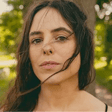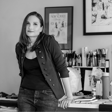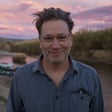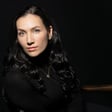Become a Creator today!Start creating today - Share your story with the world!
Start for free
00:00:00
00:00:01

Episode 96—Emily Poole Illustrated
"When you need stuff done in conservation, you've gotta connect with the heart," says Emily Poole, illustrator for "Birdnote." Hey, it’s the Creative Nonfiction Podcast, the show were I speak to the world’s best artists about creating works of nonfiction, leaders in narrative journalism, doc film, memoir, essay, and radio and tease out habits, origins, routines and punishing self doubt so that you can apply those tools of mastery to your own work. I’m your host, Brendan O’Meara, hey, hey… Today’s episode is a little different for a couple reasons. One, it’s the first IN-PERSON interview in the history of the podcast. Two, it’s with an illustrator, whose book, "Birdnote: Chirps, Quirks, and Stories of 100 Birds from the Popular Public Radio Show" (published by Sasquatch), is out now. Said illustrator is Emily Poole (epooleart on Instagram). Emily banged out 100 original illustrations and the cover for 101 paintings in about three months time. How’d she do it? Bird by bird, buddy #AnneLamott. In this episode you’ll learn about: How Emily set up her days to accomplish this incredible feat of work. How she’s able to process useful criticism vs. criticism that’s more hurtful than helpful. And why art is important in the world of conservation. Anyway, this was a fun conversation and I hope you dig it. Be sure to pick up a copy of Birdnote for the bird lover in your life. It won’t disappoint, and neither will Episode 96 with Emily Poole! Subscribe to the podcast wherever you get your pods and consider leaving an honest review on iTunes to help bolster our little corner of the CNFin' Internet.
Transcript
Studio Setup and Podcast Introduction
00:00:00
Speaker
I need foam. I need foam on these walls. It's a little too echoey. Countdown to the riff begins in five, four, three, two, riff.
00:00:16
Speaker
Hey, it's the Creative Nonfiction Podcast, the show where I speak to the world's best artists about creating works, nonfiction, leaders in the world of narrative journalism, doc film, memoir, essay, and radio. We tease out habits, origins, routines, and punishing self-doubt so that you can apply those tools of mastery to your own
First In-Person Interview with Emily Poole
00:00:38
Speaker
work. I'm your host, Brendan O'Mara. Hey. Today's episode is a little different for a couple reasons.
00:00:44
Speaker
One, it's the first in-person interview in the history of the podcast. Two, it's with an illustrator whose book Bird Note, chirps, quirks, and stories of a hundred birds from the popular public radio show just launched. It's published by Sasquatch.
00:01:05
Speaker
Said Illustrator is Emily Poole. E-Poole Art on Instagram, so that's E-P-O-O-L-E, Art. And Emily banged out a hundred original illustrations and the cover for 101 paintings in about three months time. It is a gorgeous book and she's super talented. How'd she do it?
00:01:34
Speaker
bird by bird buddy, hashtag Ann Lamott. Sorry. Sorry. I promised I wouldn't do it and I did it anyway. In this episode, you'll learn about how Emily set up her days to accomplish this incredible feat of work, how she's able to process useful criticism versus criticism that's more hurtful than helpful, and why art is important in the world of conservation.
00:01:57
Speaker
Anyway, this is a fun conversation. I hope you dig it. Be sure to pick up a copy of Bird Note for the bird lover in your life. It won't disappoint. And neither will episode 96 with Emily Poole. Really silly right now. Why do you feel so silly? Because I'm holding a giant microphone. You're the first one to hold said microphone. Cool.
00:02:29
Speaker
All right. See, this is a good experiment that you're like the first in person. You're going to do so much editing on this. There's a good chance of it. And I'm okay with that because this is going to be well worth it. And I'm coming in way hotter than you are on this. I'm just changing up the levels here.
00:02:57
Speaker
Okay. All right. So keep that. You got to keep that thing fairly close to your mouth. That's even worse. And now I have the feeling that it's
Emily's Artistic Journey and Influences
00:03:07
Speaker
like seventh grade talent show. My crush is in the audience and I'm up there trying to sing. Don't stop believing.
00:03:18
Speaker
That is hilarious. But the music hasn't started. I'm here with the microphone. Everyone's looking at me. That's great. And everyone and the thing is no one's looking at you. That's what makes us even better. And you sound great. You sound great. Oh, man. So like most of the conversations I have, I always love to start at the beginning. What makes this a little on the weird side
00:03:43
Speaker
For me is that I know a lot of your your story and know a lot about about your Backstory, but I have to like ask it as if I don't know. Yeah. Yeah, so that makes this in a sense for me even weirder So I'm mildly concerned that I'm gonna assume that you know things and like forget to tell it like forget to answer you thoroughly So we're both
00:04:06
Speaker
Yeah, it is an interesting situation and it's experimental, but I think it'll work just fine. So as we all know, you grew up in Jackson, lots of kids, every kid draws, but you kept drawing.
00:04:26
Speaker
What gave you the or who gave you the permission to just like keep on going with it instead of it being like beaten out of you in middle school or high school. And that happens to a lot of people. Well, I was raised in the middle of a swamp with no one around. So it was me and my parents and the nearest kid was a long ways away. So
00:04:49
Speaker
I mostly just kind of had to come up with ways to entertain myself so drawing was really kind of what I did all day rather than playing at the local park with the other kids because there was no local park and no other kids so drawing and reading were kind of my hobbies and I never really
00:05:06
Speaker
did anything else. Um, and you know, I'm lucky to have parents that support what I do. And so they never said, Oh, you should be out playing sports ball with the other kids. Yeah. So they didn't think you were like weird. Let me do my thing. Yeah.
00:05:20
Speaker
Yeah. So much of what you draw is from the natural world and everything. So were you always just drawn to animals and have a kinship to want to bring that off the page in a sense? Yeah. I was going through a lot of my old sketchbooks recently, and most of my early drawings are animals of one kind or another.
00:05:47
Speaker
So why do you think? I've always drawn animals. Yeah. So why do you know some people some kids get into they like to draw like when I was little I know I I really latched on the Calvin and Hobbes and I like would like I drew tons of like Calvin and Hobbes to Calvin and Calvin Hobbes ish type little comic strips because I just really love that stuff. And I believe his name was
Conservation Art and the Guyana Experience
00:06:12
Speaker
like phases.
00:06:13
Speaker
Yeah. Yeah. So like, what were some of those phases? Oh, well, there were the embarrassing ones, like, you know, cats with anime eyes was probably the fifth to sixth grade. And then seventh grade, I got really into dragons because of this one, how to draw dragons book that all the kids were passing around. Yeah. So I was drawing a lot of dragons for a while. I did do comic strips for a brief period, mostly about cats, really bad jokes. Do you have any, can you remember or recall any examples of that?
00:06:44
Speaker
No, mostly just the anime eyes haunt me. You just see them in the back of your eyelids, these anime feline eyes.
00:06:57
Speaker
So yeah, so that was a particular phase, dragons too. But like eventually like animals and specifically birds really latched on to you. Like, can you recall a moment when like that really galvanized as something that was like, Oh, wow, that's something that I really want to lean into.
00:07:16
Speaker
Probably not until late college. Because for my first couple years of college in art school at Rhode Island School of Design, I wanted to be a science fiction fantasy artist. And then I kind of found that that scene wasn't really for me for several different reasons. And looking at my portfolio, it was sort of a mix of like creature design and animal design and
00:07:44
Speaker
stuff that I just didn't enjoy as much, but I felt I needed for my portfolio for science fiction, like people and action and everything, but I really just liked drawing the animals. And then I started to draw actual animals more and more often. And then I kind of decided, oh, this is the greatest thing ever. The actual, I guess the actual moment that I decided that I wanted to do like natural history and especially conservation geared art was when I went on a trip with one of my professors to Guyana.
00:08:13
Speaker
And we did projects there. And we did research projects. We got to pick some sort of natural history topic and we both researched it from a scientific point of view and also illustrated our scientific journey. And I had so much fun with that and I thought it was the coolest work ever. And at the end we gave a presentation
00:08:38
Speaker
to all of the local people about what we had learned and just teaching people about the animals they lived with, with my art, I thought was just the greatest thing. So I leaned into it hard after that because I really, really liked doing that.
00:08:53
Speaker
So talk about your professor a little more. How'd you guys get to know each other and become acquainted and to the point where it was something that she was willing to sort of take you under her wing and invest in you and bring you on to a foreign country in South America. So what was that relationship like and how did you come across her?
00:09:21
Speaker
Well, I took her class that she was teaching with another professor of mine who I had already taken a class with, and they were jointly teaching a class called Visualizing the Natural Sciences. So he was teaching this sort of visual arts part, and she was teaching the science part. So she would present science topics to us, and then we would work on coming up with a way to visually interpret them.
00:09:49
Speaker
And the folks that did well in the course that seemed dedicated to that sort of line of thinking and that line of artwork, she invited to come on the Guyana course afterward. And what's her name?
00:10:03
Speaker
Her name is Lucy Spellman, and she's a very impressive person. She worked with mountain gorillas in Rwanda for a while. She was the director of the National Zoo for a long time, and she became a professor at Rhode Island School of Design after
00:10:21
Speaker
coming to this sort of realization that scientists need artists to be their voices, because scientists are great at communicating to other scientists, but as far as making the information that they find accessible to the public, sometimes it's just not engaging, people don't listen that well, and art sort of, art tugs at the heartstrings, and art connects with the heart, whereas science connects with the head, so...
00:10:47
Speaker
When you need stuff done in conservation, you've got to connect with the heart in order to get people to care and do anything. So science collaborating with art to reach people in a meaningful way, she decided was the most important thing to her. So she started teaching at an art school to try to realize that.
00:11:08
Speaker
What do you think it is about art and something that's visual that can just, that can maybe like cut through so much of the noise and clutter that makes something that might be more, I don't know, esoteric or science-y based, it kind of makes it more accessible to maybe a common reader that might be able, a common reader or a common consumer of sorts that
00:11:38
Speaker
What's the word I'm looking for? It can have a deeper meaning. It seems to cut through the noise and cut through a lot of that clutter that maybe some of the science ease fails to do, but something what you can do and accomplish makes it much more accessible to an average reader or average consumer.
00:11:58
Speaker
I think accessibility is partly a lot about the venue that you experience art in because art can be anywhere. It can be on the subway wall or on your own wall or on your Facebook feed as you're scrolling past or really just about anywhere.
00:12:19
Speaker
It has, you know, it has a way of catching the eye. That's what art is. It's designed to grab you and hold your eye and then make you think if it's good. So, um, you know, not a lot of people out there, just the average Joe are going out and reading scientific papers.
00:12:37
Speaker
on the Harvard Science School database. But art can pop up just about anywhere and grab you. And even most people will visit a few galleries in their lifetime, even if they're not that interested in art. So I think it's kind of that...
00:13:00
Speaker
that dual thing of both appearing in places you don't expect when you're you might be ready to look at it and just you know being anyone can look at a piece of art not anyone can read the science and understand it but anyone can look at the art
00:13:16
Speaker
Yeah. When you were really starting to sink your teeth into illustrating and painting, and you just said something like an artist can really grab and hold a consumer, just a purveyor of the arts. Who was
00:13:37
Speaker
taking who was grabbing and holding you when you were coming up as an art developing as a You know it, you know through through high school and college like who were those people that were like inspiring you So much to like pick up pick up the pen and or the paintbrush and do what you're doing Like who are those people? Well
00:14:04
Speaker
I have a two-part answer. A lot of artists that really inspired me are really old artists. Like Ernst Haeckel is my favorite. I would make an embarrassment of myself if I tried to say a time that he worked because I do not specifically know. But he worked in a time where everyone was a naturalist as a hobby. People were just really interested in the natural world, like the kind of Victorian type
00:14:34
Speaker
era where everyone collected specimens and everyone was really into botany and there were all these illustrators out there that were doing natural history work and illustration work and it was all terrible because people would get specimens brought on a ship from
00:14:56
Speaker
really long way away and all kinds of weird stuff that happened to the specimens on the way or just like wrinkled my absolute favorite illustration yeah exactly my absolute favorite illustrations the illustrations done by
00:15:13
Speaker
Those poor people who tried to reconstruct animals based on the descriptions of sailors who had been to places and seen the animals. So there'd be an illustrator in a London port that would, you know, the ships would come in and he'd call up a sailor and say, describe a kangaroo to me.
00:15:35
Speaker
You know, you have to go by a sailor's description. They're not the most reliable people. Yeah. They've got their rum rations and everything. Oh, yes, a kangaroo. It's 15 feet tall with claws the size of your arm. It's got a pouch. It's got a bit of a blobby thing on the back.
00:15:55
Speaker
So the animals they came up with from these sailors did like verbal descriptions of stuff they'd seen a while ago, while not probably not, you know, either from scurvy or whatever else in your total right minds, they did the best illustration. So I really love those because people just were so dedicated to chronicling the natural world that they would put themselves through that in order to do it.
00:16:22
Speaker
And then, you know, there are modern illustrators that I really admire. There's a person called Zoe Keller who makes really, really great work about different ecosystems and the animals you find there. An artist named Tiffany Bozic that I really admire.
00:16:38
Speaker
a really old Russian artist named Ivan Billabin. He's most famous for his illustrations of Vasilisa the Beautiful. But he has this beautiful decorative painting style that I really enjoy. Like half of my inspiration is from really decorative artists because I like, I like decoration. My art school education would frown on me for that. And then have, you know, natural history illustrators I love.
00:17:07
Speaker
So what do you mean by decoration? What really inspires me is actually the animals themselves. I rarely see other people's work and think, oh, I want to do that. Mainly just because I've been hard steered away from imitation or anything like that. And being inspired by other people is an imitation.
00:17:32
Speaker
What really makes me want to paint is finding out about a really cool animal or plant or anything else and saying, I have to paint that so I can show other people because that is the neatest thing ever.
Bird Note Project and Artistic Discipline
00:17:45
Speaker
Because there is just so much cool stuff in this world and I just want to get it in front of people.
00:17:54
Speaker
And my art is kind of a medium for me to do that. I find out something neat. I make a painting of it, and then I put it out there and say, look at that. Isn't that cool? Yeah. You let that do the talking for you. You're like, here's this cool animal. I'm going to paint it in its most characteristic phase. And that's going to do all the talking I want it to do, whatever that is.
00:18:21
Speaker
And what is it specifically about birds that really sort of galvanized as like you're sort of the animal that really, you know, you really sort of locked into specifically for, you know, for the, for the bird notebook.
00:18:38
Speaker
really know how that happened I didn't really paint all that many birds even even in college when I first got into into animal illustration I never painted that many birds and then the birdnote job came along and yeah I really don't know how I got on the bird kick
00:19:01
Speaker
I had drawn a few words. I'd done some work for the Teton Raptor Center, which is a raptor rehabilitation center in Jackson, Wyoming. And they had me do some paintings and drawings of their permanent resident raptors there.
00:19:15
Speaker
And I did really enjoy that, but Bird Note was my first foray into intensive bird art. And I loved it. I loved it so much that after I did Bird Note, I thought I'd be, I was certain I'd be sick of birds, but the first thing I did after I finished Bird Note was draw another bird. And that's just about all I've drawn since then. So, that's where your brain solid bird kick. Yeah, it's amazing that, you know, given the volume of work you did for Bird Note that you,
00:19:43
Speaker
were not just totally burned out on birds. When I spoke with Noah Stricker, in talking to him about his record setting birding year for Birding Without Borders, after he was done, it kind of had a similar conversation. The first day after,
00:20:03
Speaker
He set that record of, you know, globetrotting, breaking the world record of seeing them over 6,000 birds. The first thing he did the next day was go bird. And so it was just so baked into his DNA to do it. And it sounds like it's kind of similar for you. Maybe birds have a special power. It's a bird thing. They're just that enchanting.
00:20:26
Speaker
Or did that surprise you that like the first you know, your hundred first painting ended up being like another bird after doing 100 of them? Yeah, it kind of did. But also like I'd really gotten birds down at that point. But I did have a long period after that where I couldn't seem to muster any enthusiasm for painting in general.
00:20:52
Speaker
So I did have a burnout. I kind of didn't want to paint anything for a little while after I finished Bird Note. I think I just used up all my painting energy for the year and one fell swoop and just had to kind of wait out the rest of the year.
00:21:08
Speaker
How did you work your work your way through that? Or maybe like maybe the first step is to say like kind of diving into the process of the book to give people an idea of the volume of work you were doing. So let's say how let's go right to the start of bird note and say like, how did you get that job and then and what did that job entail?
00:21:33
Speaker
Well, I got the job like six months previously, or maybe even more. I had sent a postcard to the art director for Sasquatch Books, because that's kind of still how illustrators do it. I'm not sure why, but that's still the system. If you want to get jobs with publishers, you print out postcards of your work, and you send it by a snail mail. That's still how a lot of people do it, and that's how I've gotten all my jobs up until this point.
00:22:00
Speaker
Which is kind of, you know, it's kind of fun, traditional. Kind of expensive in printing. And then, so six months after I sent that card, I actually, while I was in Guyana for the second time, I received an email and it's memorable because
00:22:22
Speaker
We got internet access for half an hour between 4 and 4.30 a.m. at the compound that we were staying at in the interior of Guyana. Because the internet was so expensive to get out there that they didn't want people on it because it was just so pricey. So they turned it on only in the middle of the night for people that were so desperate to check their email or do whatever else that they were willing to get up at 4 a.m. to do it.
00:22:51
Speaker
so they like tell you like hey everybody before you go to bed tonight set your alarm for four o'clock yes internet will be available for 30 minutes yes
00:23:03
Speaker
So I checked my email for the first time in a week at 4am and saw that this email from this art director at Sasquatch Books had been sitting in my inbox for a week. So I immediately wrote her back, Oh my God, I am so sorry. Yes, I want this job. Please don't have picked someone else by now. Yeah.
00:23:25
Speaker
And the job was 100 illustrations, later amended to 101 when they had me do a separate book cover, which I think opens up for a lot of Dalmatians jokes that I've tried to make, but none of them quite work out. Even Dalmatians and illustrations rhyme, but I still haven't been able to make a good job. Yeah, keep work shopping. There's something there.
00:23:48
Speaker
100 illustrations for this book showcasing 100 short essays on bird behavior from Bird Note, which is a podcast put on by some folks up in Seattle, same place as Sasquatch Books. It's just a little two-minute podcast, easy to find, go look for it.
00:24:11
Speaker
on interesting facts about Burt's. So they were doing this book version. It would be one illustration per essay, 100 essays, 100 illustrations. And the timeline for that, I think they had me start work in early April. I had to have detailed sketches by June, and I had to have all of the final paintings turned in by the end of August. Hmm.
00:24:37
Speaker
So all right, so how were you setting up your days so you could accomplish this? And what were the shape of your days as you were doing that? Well, I bought a calendar, because I'm not on top of it. I bought a calendar and I just calculated the number of illustrations I needed to be doing per day and marked them all out on the calendar. How many was that per day?
00:25:07
Speaker
I know in the painting phase, it was three paintings a day on all my days that I got to paint. Sketches, I think maybe it was a little tighter or maybe it was the same. I mean, yeah, it was like a full on sprint for... Yeah. Yeah. Yeah. So I marked it all out on the calendar and I gave myself a little wiggle room and I gave myself kind of
00:25:31
Speaker
like extra sort of cheat days where if I totally fell off the painting wagon it wouldn't be the end of the world. So I just, I boxed them all out three boxes a day that I got to check off because I love checking off boxes. That's my favorite thing about to-do lists.
00:25:50
Speaker
And I just stuck to that calendar because there you know, I had to there was no there was no option to fail Yeah, this was such a big job and such a job that I really wanted to do that turning it in You know turning it in late or delivering low-quality work was just not even an option and
00:26:12
Speaker
Right. That's it. It's it's amazing because, you know, this is your. Yeah. Like, would you characterize this as like your first big gig out of school? Yeah. So were you how are you sort of processing and not getting overwhelmed by the pressure of it? You know, as this being your first big gig out of pretty much out of school?
00:26:39
Speaker
I don't know, I trusted in the same thing that got me through college, which is just, I believe in myself enough that I know I will get things done.
00:26:54
Speaker
I absolutely will get it done if I just try hard enough. Um, and that's, that's what got me through a lot of really tough spots in college. I got mono during finals my sophomore year and I still, you know, I didn't remember making any of it, but I still put all the work on the wall during finals. Um, you know, I just.
00:27:19
Speaker
I don't turn in work late and I don't turn in low-quality work. Those are my two pillars that I do not deviate from. So everything else in my life is flexible. Those two things are non-negotiable. Where does that belief come from? I'm a little afraid that if I examine it too closely, it will shatter. I don't exactly know.
00:27:46
Speaker
I've just, I've kind of always, always been like that. I just determined to get, to get everything done. I don't know if that's like, like a teacher's pet tendency. Like I don't want anyone to be disappointed in me or I think it's more for myself. I just don't like, I don't like letting myself down. Um, and this just was a job where I couldn't let myself down.
00:28:10
Speaker
Yeah, Ellie, you say your parents are very supportive of your drawing and your art. Was it them that put that belief in you that you could essentially accomplish anything you put your mind to? Oh my god, we're still searching. Well, I'm not like,
00:28:38
Speaker
Oh, I'm amazing. I can do anything. Wonder of the world. I definitely don't think that.
Artistic Growth and Technical Skills
00:28:46
Speaker
And I do have a lot of fears. I think my parents do have something to do with it. My parents, they, you know, I wish I could ask them because I'm sure they'd be able to word it better than I can. I only have my suspicions.
00:29:06
Speaker
But I think my parents were very determined to make me self-sufficient. So whenever there was a problem in my life, rather than rushing in to fix it for me, they'd say, oh, that's too bad. What are you going to do about that? Or, oh, that's a shame that you're having a terrible time. How are you going to fix that?
00:29:27
Speaker
So I guess I kind of like, I was sort of raised with the attitude of no one's going to fix this for me and I'm going to have to push through because the other option is to just lay down and die and I don't have time for that.
00:29:41
Speaker
I was having this great conversation with Kevin Wilson last week and you know, he wrote these great books that are like sort of focused on baseball players primarily and hitters within that discipline and he
00:30:00
Speaker
One of his major tenets is, you know, you identify your strengths and your weaknesses and instead of trying to level up your weaknesses to your strengths, which he argues
00:30:12
Speaker
Will make you more average He's like his thing is like you identify what you're strong at and you really double down on your strengths because you know most most hitters or pro ballplayers and pro athletes they tend to be good at one thing and they get paid for that one thing and I wonder what
00:30:34
Speaker
What would you identify as your strength and is that something you consider yourself leaning into or do you want to identify weaknesses and try to bring those up? I Have a tendency to lean into the strength, but I feel like I should be leveling up the weakness because
00:30:56
Speaker
I always feel pressured to create new work that's going to be portfolio worthy so that I can show the people that might want to hire me that I'm creating new things, I'm getting better, and I'm always putting out new, good work that will hopefully entice them to hire me. So as much as I would like to, I often feel like I don't have the time and the pressure-free environment to
00:31:23
Speaker
Work on leveling up the weaknesses because that requires me producing a bunch of bad work that I don't want to show anyone And it's another thing that I unfortunately don't don't have time for a lot of the time But there are a lot of weaknesses that I want to build up because I think they could play to my strengths once they were on that field You know there are for example
00:31:51
Speaker
I want to do more work with a decorative design with shapes and with patterns and just more visual design work in tandem with my
00:32:09
Speaker
more technical, you know, drawing a bird foot. I know how to draw a bird texture. I can draw fur, I can draw a leaf, but arranging those in a way that's visually pleasing and maybe adding in other elements that aren't animal textures. I'm not quite so strong on and I think that
00:32:29
Speaker
Once I got those skills up, then they would play into my strengths. They wouldn't be a separate thing. I just said that really badly. I tried. No, I think you said it perfectly. What would you identify as something you feel particularly strong at? Something to do with craft or something to do with anything.
00:32:57
Speaker
Well, you know, I, you know, this being a long form type interview, I let's give him the choice between the two. I say both. So craft away. Yeah, we go craft and then the other craft wise.
00:33:14
Speaker
I really like what I'm able to do with color, which is not a me thing. It's a good art and education thing. I think I got my money's worth out of RISD just on.
00:33:29
Speaker
learning to work with color because that's a thing that a lot of artists really struggle with and I put myself through some classes I really was not at all suited for and were extremely painful to me so that I could learn to make color work for me. And I think that that was a good decision in the long run.
00:33:49
Speaker
Yeah. So much of your work, it is like very just like pleasing to look at, you know, and that probably goes to what, you know, being able to identify what colors work well together, whether it's like your gift cards or, you know, the hundred and one illustrations and bird note, they just feel like they just, you know, they fall on the eye. Well, that makes any sense.
00:34:14
Speaker
Yeah, it's basically due to a couple basic principles of how color works. So with BirdNote, I actually...
00:34:24
Speaker
It almost felt like cheating because I had to come up with a formula for producing the illustrations, which was I basically had on my palette, like a section for this is how I'm going to paint a brown bird. This is how I'm going to paint a white bird. This is how I'm going to paint a black bird. And I had the same colors that I used about every time. My justification for that being that all the work would be pretty visually consistent.
00:34:49
Speaker
all the birds would look like they were in the same world because they were painted with the same palette. But there's a couple foundations to color that carry my work through that are not me being good at color but me just following the rules.
00:35:07
Speaker
Are you interested in all so you've got like, there is a particular playbook there of what colors work well together? Is there a part of you that wants to break those rules and just do something that's just cut against the grain? Yes.
00:35:24
Speaker
Yes. Now that I've more or less learned the rules, I certainly do not know everything. Now that I've more or less learned the rules, I'm working on starting to break them, which is one of the things that I want to level up is my ability to work a little bit outside of the box of what I know will work and trying some stuff that I don't know will work. I've got this really great
00:35:48
Speaker
advertising design book from like 1982 that's color palettes for advertising and they're separated into sections by mood. So it'll be like active mood and there'll be a picture of a person in a magenta snow suit with a bright blue sky skiing or you know angry mood or intense or dreamy and these are palettes meant to be used on like billboards in the 80s.
00:36:15
Speaker
They're the most obnoxious color combinations ever and a lot of them don't make sense to me. So my favorite thing to do when I don't know what to do with color on a piece is pull out the advertising palettes book and pick one of the palettes they've given me and then try to make it work. Nice. Is there a particular one like can't get out of bed mood?
00:36:39
Speaker
You know, since it's an advertising book, can't get out of bed isn't something you usually want to instill in your consumers, so they did not include that. Alright. It could have worked for like a Zoloft commercial, I guess.
00:36:53
Speaker
So I'm still amazed that you were able to like, your first inclination was to still paint birds after doing 101 of these things. It still blows my mind that you still had a requisite or inherent love of that degree of work.
00:37:16
Speaker
to want to just keep pursuing it. So the only way to do that amount of work is to fall in love with it because otherwise you're just going to have a terrible time. If you're not that into painting birds and you have to paint 100 in two months, it's going to be rough. So I decided that I loved painting birds because that was how I was going to get through is because I love doing this. So I fell in love with painting birds and that, you know, that lasted until after I did the work.
00:37:43
Speaker
So there were, undoubtedly, there were some that were probably a grind to paint through, and then there were probably others that were very exciting and very fun to do. Which ones were most fun, and which ones in the book are you most proud of? And you think you look at it, you open up that book, and it's just like, ah, man, that's some cool shit right there.
00:38:09
Speaker
To be honest, I think my very favorite illustration in that book is illustrating the essay on why bird poop is white. And I got a specific request from the editor of the book to paint white bird poop on a red car.
00:38:26
Speaker
Which, you know, I really like to stick to animals. I don't even like getting architecture into my work, so painting bird poop on a red car was the least appealing thing I'd ever heard. But I kind of thought, okay, I am gonna nail this one. I'm gonna make this a really good one.
00:38:48
Speaker
I'm not going to settle for just drawing the corner of a car and painting some bird poop on it like it's a textbook illustration. I'm going to make this mine just to see if I can. So I ended up doing a painting of a red car in kind of dappled sunlight framed from above by the heads of these birds looking down on the car kind of smugly. Yeah. It looks like there's intentionality from those birds. And they were very proud.
00:39:16
Speaker
And I just, I like that illustration because I'm really, I'm really proud of the problem solving I did there. And also just rising to the challenge of how can I make this not inherently exciting subject still something that is pleasing to paint and will feel like my illustration at the end
Daily Routine and Managing Workload
00:39:34
Speaker
of it.
00:39:34
Speaker
Yeah, that particular illustration had a very far side feel to it. It's just like they were doing this with intention and spite. So as you know, I love to dive into routines and artist routines. And so throughout this process, when were you waking up in the morning? How are you sort of checking in with yourself?
00:40:03
Speaker
so you could have that productive day when you were really you know had to get those three paintings done in a day and so how were you like setting up your lead dominoes so you know come nightfall you know things were you could you could go to bed hit the have your head hit the pillow and be like all right that's a good day let's get to the next day like so how are you doing that
00:40:25
Speaker
Well, the first thing that you have to know about me as a worker is I do not compromise sleep. I don't do it. I don't ever compromise sleep. I don't cut into my sleep schedule on either end. I don't stay up late and I don't wake up early. I did that. It didn't work out for me.
00:40:47
Speaker
I don't do it anymore. So I'd get up at a respectable seven. Make myself a cup of tea and just get working right away.
00:41:05
Speaker
When you have to work and you don't want to, or when you have to work and there's a long, long project ahead of you, the house starts feeling a little bit like an obstacle course. Like you gotta get out of bed and then you gotta make sure you don't crawl back into bed while you're getting dressed. And then when you're going downstairs, you gotta dodge that couch that looks really good. Make your cup of tea and then dodge that couch again on the way to the studio. It's full of pitfalls and bear traps.
00:41:33
Speaker
Yeah. But if I can make it to the studio with my cup of tea without getting sucked into the black hole of a comfy piece of furniture on my way there, then I'm going to have a good day. Yeah. It's a lot harder than it sounds. Well, you've got the whole thing where the bedroom's upstairs in your apartment, then you have to go down, make the tea.
00:41:55
Speaker
and then walk past the bedroom and then into the studio so yeah you're dealing with like you're just throwing hurdles in front of you the whole way well when i was working on this project my studio was still in the living room so my desk was right next to the couch which was a terrible setup yeah i literally had to buy a partition
00:42:18
Speaker
and put it between me and the couch so I couldn't see the couch. This is how much self control I have. I love the mind games that people have to play with themselves so that they can get the work done. Ultimately, it's all about, you know, they always talk about the ass in the chair. And it's like, it's a grind. 99% of it is a
00:42:40
Speaker
Hell, it's just a grind. Yeah, and you had to put up a partition so you couldn't see the temptation that was a yard away. Yeah. So if you were able to avoid all those obstacles, you got your butt in the chair, then what did the rest of the morning and afternoon look like?
00:43:05
Speaker
Um, I get some music going or I put on one of those TV shows that you don't have to watch in order to follow. Like one of those TV shows that takes place in the same room the entire time, like friends or parks and rec, like the setting doesn't matter. You can just kind of listen and they'll keep you company or I put on music. Um, and then I'll just go until I get hungry and food break, another cup of tea, keep going, dodge the cash.
00:43:35
Speaker
You're right.
00:43:36
Speaker
Um, after dinner, I'm done. I cannot work after dinner. I try, it doesn't happen. Um, so that period between breakfast and dinner is crucial for maximum work. While I was working on this project, I, you know, and the temptation to go outside is pretty strong. Um, while I was working on this project, I was lucky sort of in that it was about 110 degrees for two months straight. And I had no temptation to go outside whatsoever. Yeah.
00:44:07
Speaker
Yeah, yeah, that keeps you inside. How did you avoid getting overwhelmed by the breadth of the project?
00:44:17
Speaker
Well, it helped to break it down into a day by day plan and stick to that. You know, like if I get my three illustrations done today, I'm on track. So thinking about how I have 75 more to go in the next month, I'm not going to think about that. I'm just going to think three today. If I've done those three, I'm on schedule. Do it again tomorrow.
00:44:42
Speaker
that sounds very determined i of course had my my ups and downs yeah did you have any days where like you did two one day and you're like shit i gotta do four today and then if you yeah yeah yes i definitely i didn't have too many of those days because i gave myself
00:44:58
Speaker
I was very specific about this. I overscheduled myself. So each month I gave myself five freebies. So if I didn't get an illustration done, one of those days I crossed off one of my five freebies. And those totaled up to the number of illustrations I needed to do. So I was very strategic about planning to fail.
00:45:22
Speaker
Planning to fail is probably the most important thing. If failure is in the schedule, then it's not really failure. It's just another day. I can't believe I'm going to say this, but it's like in Lamont, it's just like bird by bird.
00:45:40
Speaker
Bird by bird, buddy. You guys gotta keep doing page a day is 365 pages of a book. It's just like this. You gotta incrementally break that down.
00:45:57
Speaker
Did anyone coach you to do it in that particular way to make it more manageable? Did you have a mentor or someone who suggested to be like, you're likely going to run into some big projects and the best way to sort of manage that is to break it down into those little bites instead of having to take gigantic overwhelming bites that you can't consume or swallow or digest?
00:46:27
Speaker
You
00:46:29
Speaker
Really not a lot prepared me for the scale of that job, mainly because there are very few jobs on that scale, actually.
Handling Criticism and Learning from Failure
00:46:39
Speaker
I mean, if you're working on a children's book, you're working on much more complex illustrations. But even in a children's book, it's not 100 pages. You'll do maybe 30, 35 illustrations. Still a lot of work, but not 100.
00:46:53
Speaker
know...
00:46:57
Speaker
And most of the coaching I was getting in school wasn't even for the scale of children's books. It was for the scale of editorial illustration or advertising, you know, doing a piece for the New Yorker. So people were coaching me on tight deadlines.
00:47:11
Speaker
If you're doing illustration for the New Yorker or something, they'll give you your assignment on Friday and expect it Monday morning completed. That's if you're lucky. They might give it to you Thursday night and expect it Friday morning.
00:47:30
Speaker
I had a professional illustrator who does a lot of high profile work who just told her whole class, don't expect to sleep if you're going to be a professional illustrator. You're going to have to stay up all night.
00:47:46
Speaker
I didn't appreciate that advice. I think that was bad advice. I think that's a terrible thing to tell people who are impressionable and relying on you for guidance that they should just beat themselves down and run themselves ragged and not take care of their bodies long-term. Bad advice, don't like it. But yeah, most of the coaching I received was like,
00:48:12
Speaker
you're gonna do one illustration or you're gonna do five illustrations. I don't think anyone ever sat me down and said, there might be a time when someone will ask you to do 101 paintings. Here's how you're gonna plan it out. But fortunately, I really like planning and I really like lists. So I was just lucky enough that I enjoy sticking to schedules and checking things off.
00:48:38
Speaker
Yeah, what do you think people getting into this line of work don't don't understand or don't get or maybe a better way of saying it is the people? What? What do you think?
00:48:56
Speaker
people who like make it as illustrators have that people who don't like, what do you think it is that they, those who lack it, like the sort of that business savvy of becoming an independent contractor in this line of work, you know, like what are, what are some of those skills that the people who make it have and the people who go to law school, you know, lack.
00:49:22
Speaker
I think with art a really important thing is separating yourself personally from your work.
00:49:32
Speaker
Throughout college, people in my program were dropping like flies and it was mainly because they got discouraged because they thought that people didn't like their work, that they didn't like what they had to offer the world. There were really intense critiques. We would put work up on the wall and critique for five hours and everyone would get all kinds of feedback. And I think a lot of the people that didn't make it made the mistake of thinking that the feedback they were receiving was feedback on them personally.
00:50:03
Speaker
which is not true. You've got to be able to see that your work is separate from you. It's something you make, but it's not you. And therefore, it's open to improvement. And if people are giving you advice on that, they're not attacking you. They're trying to help you. And that's illustration specific. A lot of fine artists, their work is them.
00:50:28
Speaker
They don't need to use their work as a tool like illustrators do. That's kind of the difference between fine art and illustration. Illustration is a tool. It's sort of beyond you. You're using it to communicate someone else's idea or just an idea of some kind. But the key to illustration is clear communication of a concept rather than I'm going to paint what I feel. So yeah, becoming a successful illustrator means seeing
00:51:00
Speaker
This is something I make. It can be improved. If people are criticizing that, it's not an attack on me. If people don't like it, it's not an attack on me. If people hate my work, they don't hate me. They just hate my work. And if they hate it in a way that's constructive, that's great. I'll use their feedback. If they give me things that I can improve, then they're helpful people.
00:51:24
Speaker
And if they just are hating on my work to hate on it, then they're not helpful at all. And I can just throw that feedback right now and not be worried about it. What was maybe an early experience of you dealing with negative criticism? And how did you not let that bruise you too much?
00:51:46
Speaker
Well, I have two examples. I have an example of productive negative criticism and unproductive negative criticism. Productive was, back when I was still interested in science fiction and fantasy art, I had a portfolio review with an artist I really admired. And he looked through my work and kind of looked at me and just said, you paint hands like hamster paws.
00:52:18
Speaker
For a minute, I was devastated. I was like, that's the meanest thing that anyone has ever said to me. And then I looked at my work and I'm like, no, he's right. These people do all have tiny little rat hands. And that was helpful because I just, first of all, it's hilarious. I never forgot it. And whenever I do draw hands, I don't draw hands much anymore. But whenever I do,
00:52:39
Speaker
I'm just constantly thinking like, is this hand, right? Does it look like a hamster paw? Yes, fix it. I don't know. That was a could have potentially been a negative, devastating experience, but it was helpful. So it wasn't. Yeah. I mean, it was kind of oddly put, but you know, an example of a negative experience was when
00:53:07
Speaker
And this didn't actually happen to me, but it did color my perspective on this person. A professor I had, one of the other students in the class was really struggling. She was asking him for advice. Her project just wasn't working out. And she was asking him, should I change my project? Should I try to push through this? What can I do to fix it?
00:53:30
Speaker
and he said to her, I would rather see you fail this project than start over now. You don't have time, so I'm just gonna watch you fail this. And I totally lost respect for the guy, because that's not helpful. That's completely useless feedback. Just saying you're going to fail this and your work is bad and it's not working, that's just rude, that's not teaching.
00:53:59
Speaker
Yeah, it's like, I'm just gonna watch this ship sink. Yes. You know, and just so long.
00:54:07
Speaker
Have fun. Yeah. And, you know, if you're the if you're the ship builder, you know, watch and sing. Yeah. You start giving them advice on how to plug the holes. Maybe the ship will sink anyway, but at least you tried. Yeah. So, you know, and that devastated her. And I think she actually dropped out at the end of that year. Broker completely. That's that's the advice that I would say. Throw it out. It's not helpful. Who cares if this guy doesn't like your work, if he doesn't have anything useful to say.
00:54:37
Speaker
Toss it. Yeah. Do you, is there a particular failure of sorts that comes to mind that, uh, like a favorite failure, if you will, like something that totally, um, you know, it didn't work. It was spaghetti that didn't stick to the wall that, uh, that you've really learned from and it actually like helped move the ball forward more. Does anything comes to mind?
00:55:06
Speaker
I guess it kind of depends on whether you mean a failure in my eyes or a failure in someone else's eyes. Well, I think all these kind of failures, I guess they only matter if they're failures to yourself. If they're a failure to someone else, I guess it doesn't matter. But to you, if it feels like a failure, how are you able to take that and then develop from it?
00:55:31
Speaker
Um, well, there was a time, um, I think it was my first job out of no. Yes.
00:55:40
Speaker
Yes. My first job out of college was actually a job that one of my professors had passed along to me because he didn't have the time for it. And it was to create a family crest for this rich, affluent person as a gift. I don't know who these people were, what kind of money they were moving around, but somehow this
00:56:06
Speaker
Christmas gift to an uncle was high profile enough that they had their own art director managing it. So I got in touch with the art director. And an art director's job is basically just to make sure the communication between the artist and the client makes sense. Because you've got someone who doesn't speak art trying to get an artist to do something, and that's really hard. So the art director is kind of the translator. And their job is very essential in that regard.
00:56:36
Speaker
So I had this art director giving me instructions for all the things that needed to be on this family crest, which none of it was in my wheelhouse at all, but it was a job and I was fresh out of college and I took it.
00:56:50
Speaker
So it was this family crest and it had to have these special vases on it. It had to have a pint of Ben and Jerry's ice cream in it. It had a cowboy boot. It had the person's childhood home.
00:57:06
Speaker
It was just this very odd family crest and I had to reproduce their design in a painting. So I dutifully copied it all out, did the painting.
00:57:23
Speaker
and sent it off and the art director came back and said, the client wants it to be less textured. Can you smooth it out a bit? And I kind of thought, okay. And I went in and smoothed out some of the more textured watercolor bits with opaque paint and smoothed it out and sent it back. And the client came back and apparently they just hated it. And the art director said, you know, the client's looking for something that doesn't look painted.
00:57:52
Speaker
And I said, well, I have to ask, why did you hire a painter? Long story short, they killed the job. They killed the job. I didn't, I mean, I did finish it, but they didn't want it. They paid me a kill fee and everyone walked away feeling embarrassed. So that was another lesson in like,
00:58:21
Speaker
If they hate it, sometimes there's nothing to be done. I cannot paint work that doesn't look painted. I don't know how to do that. You can't write work that doesn't feel written. That's not feedback I can work with, so I put it in the forget about it bin and moved on.
00:58:41
Speaker
for my first job out of college to get killed was very discouraging. And it certainly felt like a failure, but I think it was just yet another lesson in like, this will be a funny story in a year. And lo and behold, it's a funny story now. Yeah. What were the next logical steps for you to bounce back after that and not be crushed by it?
00:59:11
Speaker
Just keep going. Get back to drawing stuff I wanted. I think it's sort of like a palette cleanser. I just went and did a couple paintings, just quick little afternoon paintings, which are
00:59:26
Speaker
Funny enough, now my very best selling card designs and people ask about the originals all the time, but I think I just tossed them or something because they were just little afternoon paintings. Just, yeah, to cleanse my palette and get back to something I really liked. I think those paintings actually got me, those got me the bird note job.
00:59:49
Speaker
The magpie and the hummingbird were just little miniatures that I did right after that job to make me feel better. I got some glittery silver and gold paint and I just painted these birds and embellished them with silver and gold. So just kind of like on a whim. Yeah. And those are what you sent on postcards to this art director at Sasquatch and I got you this job.
01:00:10
Speaker
I sent that and I sent a really dumb drawing. Actually, the more I think about it, the more shocked I am that they are. I sent them a really dumb drawing. I had just seen on the bird feeder at my parents' house a cowbird and its adopted parent.
01:00:32
Speaker
So cowbirds, they're nest parasites. So basically, they'll just lay their eggs in another bird's nest and be like, Sia, raise my kid. Have fun. And when my chick hatches, it's going to be about three times the size of yours. Eat all the food. And he might even shove your egg at the nest.
01:00:55
Speaker
Yes, exactly. So they, you know, they're big birds and they lay their eggs in like the finch nests. So I was watching, I was watching the feeder and there was this giant baby cowbird with this little adult finch hopping around him, putting food in his mouth. And so I did this, just this little black and white doodle of this giant baby cowbird with his little finch and just a little word bubble that said, feed me small dad.
01:01:23
Speaker
And it was the dumbest drawing, but I just sent the original off in one of my, like, in an envelope with a postcard. And I'm almost certain that was the one I sent to Sasquatch. That's amazing. Like, beat me small, Dan.
01:01:40
Speaker
So I remember you saying that over the course of the, of the bird note project, that you were worried that, you know, the, the, your first drawing compared to your hundredth one was going to be, you know, worse in comparison because obviously you're going to improve from one to a hundred.
01:01:59
Speaker
And granted, like, they're going to read the to the untrained eye and they're going to, you know, they shuffle them in different orders and, and so forth. And, and a writer has the liberty of, you know, after they've written a whole thing, they can rewrite and rewrite and make everything uniform. And so, but it's not like once you turn it something in, after you finished illustration 100, you can't go back to the first one and like amend
Inspiration and Accessibility of Emily's Art
01:02:22
Speaker
it. It's done. So would have if I could have. Yeah.
01:02:25
Speaker
So how did you how did you process that and you know that that whole that whole thing of You know your development over the course of this project and not get too bogged down by you know, you're that whole I actually hit that up with a dose of My analytical planning as well. I got them to tell me what order they were gonna be in and then I figured out the order and from that
01:02:55
Speaker
made a list of what order I was going to do each bird. I did all my sketches and they gave me the list of how they would be in the book and then I broke them up so that each batch of illustrations would be evenly distributed throughout the whole book.
01:03:12
Speaker
So that if I either improved or burnt out progressively over the whole job, those bad illustrations would be equally distributed among all the others. And you wouldn't notice like paging through the book, whether there was a clump of bad ones or a clump of good ones. I made sure they were all going to be dispersed.
01:03:32
Speaker
right so maybe like the the last 10 illustrations in the book that might represent like maybe one of one or two of like your very first illustrations so right exactly like
01:03:47
Speaker
You know, if my first few were shaky, but those are numbers 10, 35 and 78. Or my last few, I was like, all right, I'm just going to power through this. I have to get it done. Those last five were numbers, you know, two, 25, 46.
01:04:09
Speaker
So in looking at your work, there is an immense amount of play and fun involved, especially with a lot of the bird stuff you do, and you do these cute little hats on so much, on a lot of them. How do you maintain a sense of play and fun so that you do avoid getting burnt out?
01:04:36
Speaker
Birds are fun. Animals are fun. I really never get sick of them. I really love that quote from Sy Montgomery during her interview with you.
01:04:50
Speaker
saying I don't always believe in myself, but I do always believe in my message. I love that. I kind of live by that. Like I, you know, I as a person can get burnt out or can get sick of art, but like animals will never stop being interesting to me and they'll never stop being fun.
01:05:09
Speaker
And anyone who thinks that animals are a dry topic and they just sit there and don't I ever get sick of drawing feathers has clearly never washed a bird because they're really dumb. They're really silly and they do the greatest things.
01:05:27
Speaker
Yeah, animals are amazing. And they're fun. And it's not hard to make them fun. Yeah. What are you with your art and specifically with the illustrations you've done with Bird Know? What are you hoping that readers and just art lovers and bird lovers are hoping to, what are you hoping that they're going to take away
01:05:51
Speaker
From this when they when they buy this book and and see your your beautiful work and the accompanying essays Like what are you hoping they take away from that? I'm hoping that the same thing will happen to them that happen to me Where they'll see the images and they'll read the essays and then they'll start seeing it everywhere That's what happened to me. It was so cool Because I learned a lot on this job. I'm not a bird expert for sure I had to be corrected by the scientists a lot because I didn't know what I was drawing half the time and
01:06:20
Speaker
I gave birds extra toes which was embarrassing. I made things way bigger or way smaller than they should have been without knowing because I didn't have the scientific intel of this is how a bird is put together.
01:06:34
Speaker
And so I learned a lot. And once I did a drawing, I started seeing that bird everywhere, doing that exact same thing that I had just drawn it doing, even though I had never noticed that before. Like I did the essay of red-winged blackbirds displaying on top of cattails.
01:06:52
Speaker
And I did that illustration and I, you know, I'd never really, really seen that. They, the males will stand on top of cattails and kind of flare up the red shoulders and just do this big hole display to impress the ladies. And I can't ever remark on having noticed that, but once I did the illustration of it, the next day I drove out to the coast, packed some marshes, and I saw all these red wing blackbirds on the top of cattails displaying just like I had just drawn them. And it was so cool. Yeah. Or, um,
01:07:21
Speaker
I did an illustration of a dipper, which are these little birds that will stand by streams and then just jump into the water and pop back out and get up on a rock and then jump into the water again. And I had never seen one before. Did the illustration. Next day I went on a hike and I saw a dipper in the stream next to the path doing that. I don't even know if I would have noticed it if I hadn't
01:07:46
Speaker
had that on my radar. So I hope that happens to other people that they just magically start seeing birds everywhere doing those things and just opening their eyes a little bit to what's around them. That is cool. Nice. So where can people get more familiar with your work online in your website, your social media presence, and where can people find the book?
01:08:10
Speaker
People can find the book just about anywhere books are sold. Your local indie, local indie bookstore is the best way to go. I'm biased because that's my, my other job. Um, but it's, you know, up on Amazon too, if you've got to do it. Yeah. The big A. Um, and my work is on my website. And what's your website? Epoolart.com. Nice. And are you on like a Instagram, Facebook, Twitter,
01:08:39
Speaker
Instagram. All right. And is that what's the handle for that? E-pool. E-pool art. E-pool art. I'm a creature of habit. Fantastic. Awesome. Emily, beautiful work. Thanks so much for doing this and being the first in person podcast on the show. So thanks so much. You did awesome. Fantastic. Thanks again.
01:09:02
Speaker
Are we already done? Seriously? I guess so. Thank you for listening. If you don't already subscribe to the show, please do so wherever you get your podcasts. Extra credit goes to those who leave honest reviews on iTunes,
01:09:19
Speaker
We're, uh, knocking on the door. We're almost in the forties, knocking on the door for fifties. That would be a Titanic achievement. I'm Brendan O'Mara at Brendan O'Mara on Twitter and Instagram. Facebook is at CNF podcast and also at CNF pod on Facebook.
01:09:39
Speaker
Twitter. Hey! You want a cool monthly newsletter? Head over to BrendanOmero.com and put your email down. Book recommendations and news about the podcast. Once a month, no spam, can't beat it. I've got a surprise next week, but you're just gonna have to wait. You'll know when it's time. Is that a teaser? Yeah, yeah, I think it is. See you right here next week, CNFers.



















